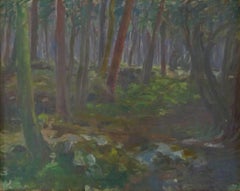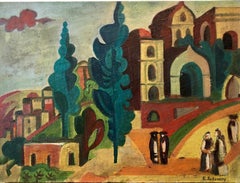Oskar D'Amico On Sale
1960s Abstract Figurative Paintings
Canvas, Oil
People Also Browsed
20th Century Landscape Paintings
Oil, Canvas
1980s Modern Landscape Paintings
Canvas, Oil, Illustration Board
2010s Impressionist Landscape Paintings
Canvas, Oil, Cardboard
2010s Contemporary Landscape Paintings
Gold Leaf
20th Century Abstract Expressionist Abstract Paintings
Oil
1940s American Impressionist Landscape Paintings
Oil, Linen
Mid-20th Century Impressionist Landscape Paintings
Charcoal, Pastel
1960s Impressionist Landscape Paintings
Oil, Cardboard
2010s Impressionist Landscape Paintings
Canvas, Oil
1960s Abstract Expressionist Abstract Paintings
Canvas, Oil
Early 20th Century Landscape Paintings
Canvas, Oil
Late 20th Century Impressionist Landscape Paintings
Canvas, Oil
2010s Contemporary Landscape Paintings
Canvas, Mixed Media
21st Century and Contemporary Photorealist Animal Paintings
Oil, Panel
2010s Surrealist Portrait Paintings
Oil, Panel
Early 20th Century American Impressionist Landscape Paintings
Linen, Oil
Oskar D'Amico for sale on 1stDibs
Oskar Maria D'Amico was an active Italian artist in Rome, Naples, Lanciano, Cisterna, Milan, Gallarate, Torino, Zagabria, Paris, Toulouse, Melun, Carenac, Maubeuge, Madrid, Barcelona, Zaragoza, Budapest, Győr, Mexico City, Cuernavaca, Morelia, Toronto, New York City, Philadelphia, Los Angeles, San Francisco, Miami, Denver, Santa Fe, Albuquerque and Socorro, between 1943 and 2003. He is considered a Nomad artist because of his ability to work in various styles. He had three major periods in his artistic life, Figurative, Materic and Geometric. He also was an outstanding art director for more than 75 epic movies. D'Amico had a very outgoing personality. He was a non-conformist, which was reflected in his work throughout his life. D'Amico was born in Castel Frentano, Italy, a small village in Abruzzo. At a young age, he felt he had to leave and dive into the big world. After being a seminarist with the Salesiani during World War II, he left Naples, where he studied architecture and began a great adventure in Rome. He specialized at the time in decorating nightclubs and bars and invented a special type of double ceiling to hide the lights. D'Amico, who was self-taught as a teenager in drawing and painting, burst onto the filmmaking scene in Rome when an art director asked him to do a perspective of set design. Soon other movie makers were calling him.
D'Amico was an art director for 75 films including two by Orson Welles. D’Amico was able to create a real marble floor in the palace of King Saul, in David and Goliath directed by Orson Welles. Art directors previously painted a simulated marble on top of concrete due to the cost of the real thing. D'Amico became an associate of Jadran Films in ex-Yugoslavia, which specialized in Roman and Egyptian constructions. While an art director, he never stopped painting. His faceless clowns, reflecting the people who had no identity after World War II, were a big success. In the early 1960s, D'Amico moved with his family to Toronto, Canada, another place he felt that was too small. He left for Philadelphia and New York City, which affected his work. He turned his focus to abstract and for more than a decade, created abstract Expressionist paintings on the plane of all matter that he called Materic. The Materic style, which he invented, was done in several media and could not be changed once on the canvas. The paintings were very well received. D’Amico sold more than 400 in Philadelphia and New York City. Unfortunately, he had to stop doing the Materics, because the colors he used were harmful to his liver. In the mid-1970s, he returned to his architectural roots and developed a new vision for Abstract Constructivism using just acrylic colors. Presented in Paris by his French Art dealer, Francoise Tournier, at the Grand Palais de Paris and in Mexico City, D'Amico's interpretation of the "New Geometry" was widely admired. In 1983, when he presented the work at the Bodley Gallery, people whispered that he had the potential to be the new Picasso because of his eclecticism and the Nomad nature of his styles. In 1987, D'Amico abandoned the gypsy life and settled in New Mexico. Albuquerque was the perfect place to dedicate himself 100 percent to his work.
There were no distractions and a good climate that reminded him of his beloved Cuernavaca in Mexico. Staying in close contact with his French art dealer Tournier, D’Amico had several shows in Denver at the Helen Karsh Gallery and in Albuquerque at the Black Swan and Café Galleries. At least once a year, D’Amico went to Europe to immerse himself in the antique world and visit museums and galleries. In 1992, visiting Tournier at the Castle of Saint Cirq Lapopie, he met the man who founded the MADI movement in 1940, Carmelo Arden Quin. D’Amico aligned himself with MADI because he had been working for years in multimedia with an abstract, geometric focus. D’Amico established the first MADI gallery in the U.S. Arte Struktura International Gallery, where he gathered all artists working in the same style and encouraged them to do group shows within the MADI rules. In 1998, D’Amico’s health declined and he gave up the gallery. His many years of using toxic paints caught up with his liver and he had energy only to do his work. He painted up to the last day he was able to stand or sit, and always said that he lived off art and love.
D’Amico was very successful in France, where people are known to be critical of artists, especially if those from the U.S. D’Amico was a naturalized U.S. citizen. He had several shows in France, starting in Paris and to the south. Claude l’Houmeau wrote in Le Figaro, “D’Amico is an experienced traveler along the intricate pathways of painting, having thus obtained a good formula which he ably exploits with his surprising virtuosity. Having also been an architect, he can construct perfectly and to maintain the balance and rhythm within his compositions which can be moved back and forth, up and down, and continue to look well in any position”. John Tancock, director of Sotheby's Modern Art Department in New York City said “… Every one of his works penetrates deeply into the axial composition and its interrelation is punctuated by the great divergence of color and tonality and the accumulated experience, using which D’Amico handles his vocabulary of forms. Thanks to the methodical and constant study D’Amico carried out, he produced a successful series of paintings that have taken on a new monumentality without impairing the vitality that is D’Amico’s main characteristic as a painter.”
A Close Look at Abstract Art
Beginning in the early 20th century, abstract art became a leading style of modernism. Rather than portray the world in a way that represented reality, as had been the dominating style of Western art in the previous centuries, abstract paintings, prints and sculptures are marked by a shift to geometric forms, gestural shapes and experimentation with color to express ideas, subject matter and scenes.
Although abstract art flourished in the early 1900s, propelled by movements like Fauvism and Cubism, it was rooted in the 19th century. In the 1840s, J.M.W. Turner emphasized light and motion for atmospheric paintings in which concrete details were blurred, and Paul Cézanne challenged traditional expectations of perspective in the 1890s.
Some of the earliest abstract artists — Wassily Kandinsky and Hilma af Klint — expanded on these breakthroughs while using vivid colors and forms to channel spiritual concepts. Painter Piet Mondrian, a Dutch pioneer of the art movement, explored geometric abstraction partly owing to his belief in Theosophy, which is grounded in a search for higher spiritual truths and embraces philosophers of the Renaissance period and medieval mystics. Black Square, a daringly simple 1913 work by Russian artist Kazimir Malevich, was a watershed statement on creating art that was free “from the dead weight of the real world,” as he later wrote.
Surrealism in the 1920s, led by artists such as Salvador Dalí, Meret Oppenheim and others, saw painters creating abstract pieces in order to connect to the subconscious. When Abstract Expressionism emerged in New York during the mid-20th century, it similarly centered on the process of creation, in which Helen Frankenthaler’s expressive “soak-stain” technique, Jackson Pollock’s drips of paint, and Mark Rothko’s planes of color were a radical new type of abstraction.
Conceptual art, Pop art, Hard-Edge painting and many other movements offered fresh approaches to abstraction that continued into the 21st century, with major contemporary artists now exploring it, including Anish Kapoor, Mark Bradford, El Anatsui and Julie Mehretu.
Find original abstract paintings, sculptures, prints and other art on 1stDibs.
Finding the Right abstract-paintings for You
Bring audacious experiments with color and textures to your living room, dining room or home office. Abstract paintings, large or small, will stand out in your space, encouraging conversation and introducing a museum-like atmosphere that’s welcoming and conducive to creating memorable gatherings.
Abstract art has origins in 19th-century Europe, but it came into its own as a significant movement during the 20th century. Early practitioners of abstraction included Wassily Kandinsky, although painters were exploring nonfigurative art prior to the influential Russian artist’s efforts, which were inspired by music and religion. Abstract painters endeavored to create works that didn’t focus on the outside world’s conventional subjects, and even when artists depicted realistic subjects, they worked in an abstract mode to do so.
In 1940s-era New York City, a group of painters working in the abstract mode created radical work that looked to European avant-garde artists as well as to the art of ancient cultures, prioritizing improvisation, immediacy and direct personal expression. While they were never formally affiliated with one another, we know them today as Abstract Expressionists.
The male contingent of the Abstract Expressionists, which includes Jackson Pollock, Willem de Kooning and Robert Motherwell, is frequently cited in discussing leading figures of this internationally influential postwar art movement. However, the women of Abstract Expressionism, such as Helen Frankenthaler, Lee Krasner, Joan Mitchell and others, were equally involved in the art world of the time. Sexism, family obligations and societal pressures contributed to a long history of their being overlooked, but the female Abstract Expressionists experimented vigorously, developed their own style and produced significant bodies of work.
Draw your guests into abstract oil paintings across different eras and countries of origin. On 1stDibs, you’ll find an expansive range of abstract paintings along with a guide on how to arrange your wonderful new wall art.
If you’re working with a small living space, a colorful, oversize work can create depth in a given room, but there isn’t any need to overwhelm your interior with a sprawling pièce de résistance. Colorful abstractions of any size can pop against a white wall in your living room, but if you’re working with a colored backdrop, you may wish to stick to colors that complement the decor that is already in the space. Alternatively, let your painting make a statement on its own, regardless of its surroundings, or group it, gallery-style, with other works.


